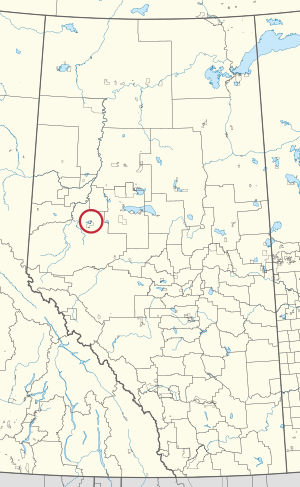Sturgeon Lake 154A facts for kids
Quick facts for kids
Sturgeon Lake 154A
|
|
|---|---|
| Sturgeon Lake Indian Reserve No. 154A | |

Location in Alberta
|
|
| First Nation | Sturgeon Lake Cree Nation |
| Treaty | 8 |
| Country | Canada |
| Province | Alberta |
| Municipal district | Municipal District of Greenview No. 16 |
| Area | |
| • Total | 753.1 ha (1,861.0 acre) |
| Population
(2016)
|
|
| • Total | 53 |
Sturgeon Lake 154A is a special area of land in Alberta, Canada. It is known as an Indian reserve and belongs to the Sturgeon Lake Cree Nation. This community is located about 45 kilometres southwest of a town called High Prairie.
In 2016, a count showed that 53 people lived in Sturgeon Lake 154A. They lived in 15 homes out of 16 available houses.
Contents
What is an Indian Reserve?
An Indian reserve is a piece of land in Canada that the government has set aside for the use of a First Nations band. These lands are protected for the First Nations people. They are meant to be a place where they can live and keep their culture and traditions.
Who Lives Here?
Sturgeon Lake 154A is home to members of the Sturgeon Lake Cree Nation. This First Nation is part of the larger Cree group of Indigenous peoples. The Cree have a rich history and culture in Canada.
Where is Sturgeon Lake 154A Located?
This reserve is found in the province of Alberta, which is in western Canada. It is within an area called the Municipal District of Greenview No. 16. The land is near Sturgeon Lake, which is a beautiful natural area.
Treaty 8 and Its Importance
The Sturgeon Lake Cree Nation is a signatory to Treaty 8. This is an important agreement between the Canadian government and several First Nations. Treaty 8 was signed in 1899. It covers a large area of land in what is now northern Alberta, northeastern British Columbia, and parts of Saskatchewan and the Northwest Territories.
What Does Treaty 8 Mean?
Treaties like Treaty 8 are agreements that set out the rights and responsibilities of both First Nations and the government. They often deal with land use, hunting, fishing, and other important matters. These treaties are a key part of Canada's history and how it works with Indigenous peoples.

